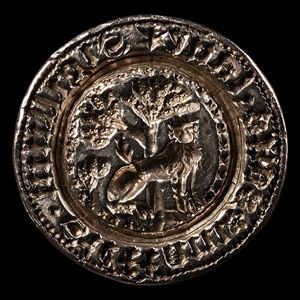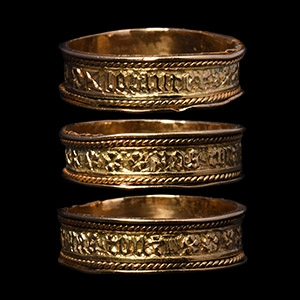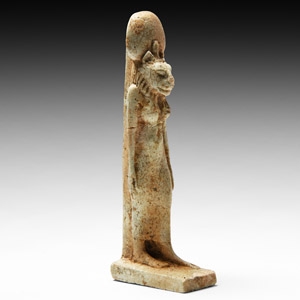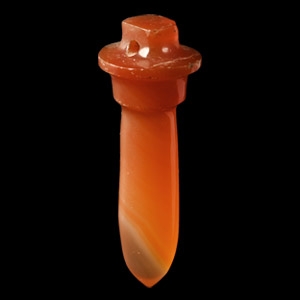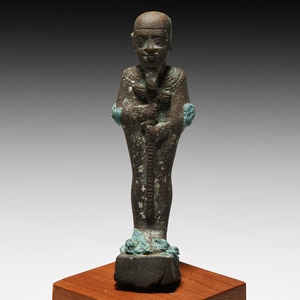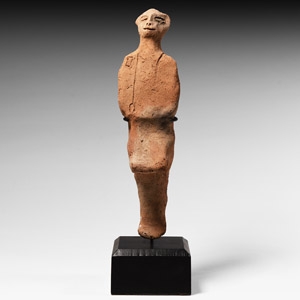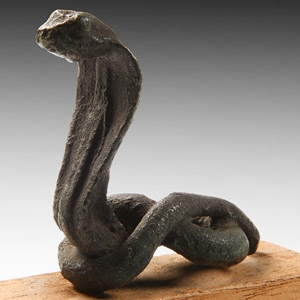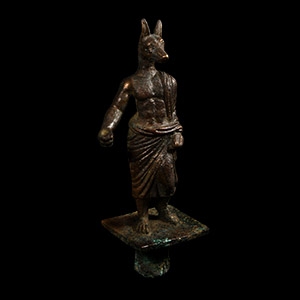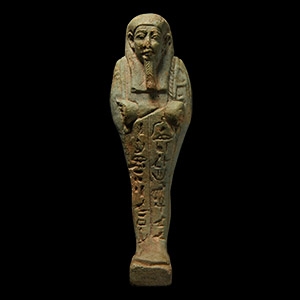Home > Auctions > 21 - 25 February 2023
Ancient Art, Antiquities, Natural History & Coins
Auction Highlights:
Acquired early 1990s.
Ex private American collection; thence by descent.
Private Swiss collection since 1998.
Cf. similar figure in the British Museum, London, under accession number 9,9,86,64.
Private collection, acquired 1999.
Cf. Andrews, C., Amulets of Ancient Egypt, London, 1994, item 83(c), for type.
Acquired 1980s.
Private collection of L.H., Staffordshire, UK.
Property of a Sussex, UK, teacher.
Cf. The Metropolitan Museum, accession number 04.2.405, for similar; Tiribilli, E., The bronze figurines of the Petrie Museum from 2000 BC to AD 400, London, 2018, p.107 no.146, for a similarly detailed example from Saqqara.
Ptah was the god of Egypt's capital city Memphis and master craftsman of the gods, known for his benevolent and approachable character.
Acquired 1979-1999.
London collection of the late Mr S.M., thence by descent.
Accompanied by a copy of a previous cataloguing slip.
Accompanied by an original thermoluminescence analysis report no.N122j43, from Oxford Authentication.
Cf. Petrie, W.M.F., Gizeh and Rifeh, London, 1907, pl. XXVIIC, for numerous examples of crude terracotta worker and overseer shabtis of the late New Kingdom from Deir Rifeh; Janes, G., The Shabti Collections 6. A Selection from the World Museum Liverpool, Lymm, 2016, pp.516-517, nos. 271 a-c, for examples of crude mud worker shabtis of the early Ptolemaic period found at Abydos holding a stylised implement.
Many crude clay shabtis are known from provincial sites such as Deir Rifeh and Abydos, with dates ranging from the Late New Kingdom - Ptolemaic Period. This overseer figure would favour a dating closer to the earlier date, when overseer shabtis were a common feature.
Ex Joseph Altounian (1889-1954), Paris and Macon, thence by decent.
with Christie's, London, 3 July 2018, lot 29.
English private collection.
This lot has been checked against the Interpol Database of stolen works of art and is accompanied by search certificate no.11603-199738.
Cf. The Metropolitan Museum, New York, accession number 66.99.186, for a profile glass inlay of this date; cf. Riefstahl, E., Ancient Egyptian Glass and Glazes In The Brooklyn Museum, New York, 1968, p.77 no. 76, pl. XI for a similar face belonging to a royal figure inlay with separately fashioned crown, collar, and torso.
Joseph Altounian opened his shop in 1906 in Paris and then relocated to Mâcon in 1924 when he was joined by his wife Henriette Lorbet. They specialised in Egyptian and Greek art, medieval sculpture and decorative arts, selling to major museums both in Europe and in the United States. At his death in 1954 the business was taken over by his daughter, Jacqueline Altounian-Lorbet, and her husband Bernard Rousset, who then specialised in antique furniture.
Acquired from Dr Jan Beekmans, circa 1984.
UK private collection.
Cf. The Metropolitan Museum, New York, accession number 26.7.873, for similar; cf. The Saint Louise Art Museum, object number 818:1940, for a very similar parallel.
Maat and the moon god Thoth, husband and wife, together embody wisdom and cosmic order. As a divine couple, they served the sun god, Re. Like Thoth, the ancient Egyptians connected the ibis with the moon, owing to its crescent moon-shaped beak. The ibis was well known in antiquity for its refusal to drink unhealthy and poisoned water, or to kill poisonous reptiles, and set mankind an example of cleanliness; thus, like the god Thoth, the ibis offered protection against dangerous forces and served as a model for purity and good sense. Maat embodies the order that Thoth protects. Her symbol, an ostrich feather, references a bird that inhabits desert and savannah habitats, although it must never wander too far away from rivers and lakes. The ostrich cannot fly, but it is a fast runner and a strong fighter.
Ex collection of Louis-Gabriel Bellon (1819-1899), France.
Cf. Andrews, C., Amulets of Ancient Egypt, London, 1994, pp.34-5.
Private collection, since 1989.
This lot has been checked against the Interpol Database of stolen works of art and is accompanied by search certificate no.11604-199678.
Cf. The British Museum, museum number EA36064 'Solid-cast copper alloy figure of Anubis wearing a short robe and holding a palm branch', for a comparable figure of this broad period; see Andrews, C., Amulets of Ancient Egypt, London, 1994, p.46-7, for discussion; see also, Tiradritti, F., The Cairo Museum Masterpieces of Egyptian Art, London, 1999, p. 401, for a slightly more elaborate bronze staff terminal of Anubis as a Roman legionnaire (Cairo Museum inv. no. CG27694).
Anubis was the ancient Egyptian god of the dead - represented in jackal form or in the form of a jackal-headed man - and one of ancient Egypt's most iconic deities. Originally god of the underworld, he was eventually associated more specifically with the embalming process and funerary rites. His fur was generally depicted as black owing to the association of that colour with fertility and beliefs regarding rebirth in the afterlife.
French collection, 1960s-early 2000s.
From an important Paris gallery, France.
Cf. Hornung, E. and Bryan, B.M., The Quest for Immortality: Treasures of Ancient Egypt, Munich/London/New York, 2002, pp.190-91, no. 96, for two closely comparable Anubis heads from a composite inlay (Cairo Museum, inv. nos. TR 21-12-26-19/1, 19/2).
Ex private Belgium collection, 1960s.
with Vanderkindere Auctions, Brussels, Belgium, 26 February 2013, lot 261.
English private collection.
This lot has been checked against the Interpol Database of stolen works of art and is accompanied by search certificate no.11605-199743.
Accompanied by a scholarly note by Egyptologist Paul Whelan.
Cf. The Walters Museum, accession number 54.1017, for a similar figure in bronze created within this time period.
Ptah is attested from the beginning of ancient Egypt’s dynastic history and was a creator god, a god of craftsmen, and the patron deity of the Memphite region. The principal temple of the god was located in the city of Memphis. The fragmentary back pillar on this statuette indicates that it was most probably a temple offering, originally inscribed with an invocation to Ptah together with the donor’s name. Such votive figurines with back pillars naming the god and the dedicator occur in various materials, including faience and stone.
From a Worcester deceased estate.
Property of a Cambridgeshire gentleman.
Accompanied by an academic report by Egyptologist Paul Whelan.
Cf. The British Museum, museum number EA49422 'Green glazed composition shabti of Tjahorpata', for a similar shabti figure of this period; cf. The Metropolitan Museum, New York, accession number 30.8.187, for a priest shabti of this date.
Although the name of the shabti’s owner and, in particular, that of his parent, are rather unclear, the titles are clearly written and inform us that Ba-ankh-sa-sobeky served as an ‘Imy-khent priest’ associated with the Delta city of Mendes, where the principal deity was the sacred ram god Ba-neb-djedet (meaning ‘Ram, lord of Djedet’). The hieroglyph of the standing ram (Ba) forms the first part of the priest’s name. From the Late Period onwards the priestly title of the nearby city of Hermopolis Parva, ‘One who Separates the Two Gods’, also appears in Mendesian title strings, perhaps indicating that Hermopolis Parva and its religious cults had come under the control of Mendes; indeed, Mendes is thought to have been the capital of Egypt during the 29th Dynasty. The crocodile god Sobek was also worshipped at Mendes in later periods and Ba-ankh-sa-sobeky’s name appears to reflect both this reptilian deity and the traditional ram god of the city.
Acquired early 1990s.
Ex private American collection; thence by descent.
Private Swiss collection since 1998.
13 - 24 of 2116 LOTS


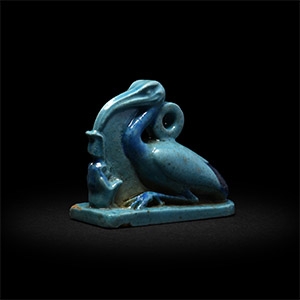



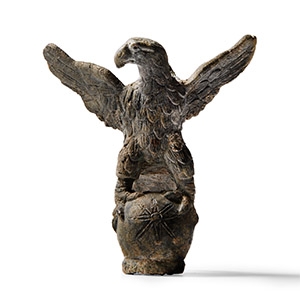
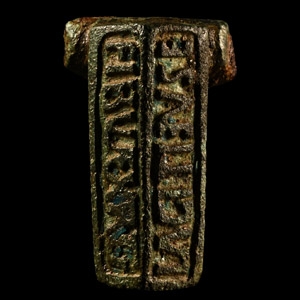

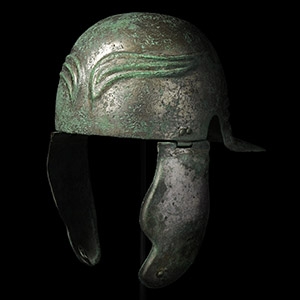
.jpg)
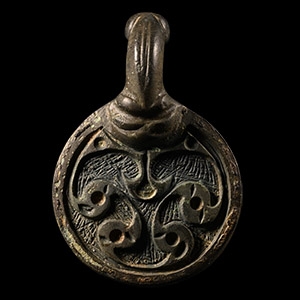
.jpg)
